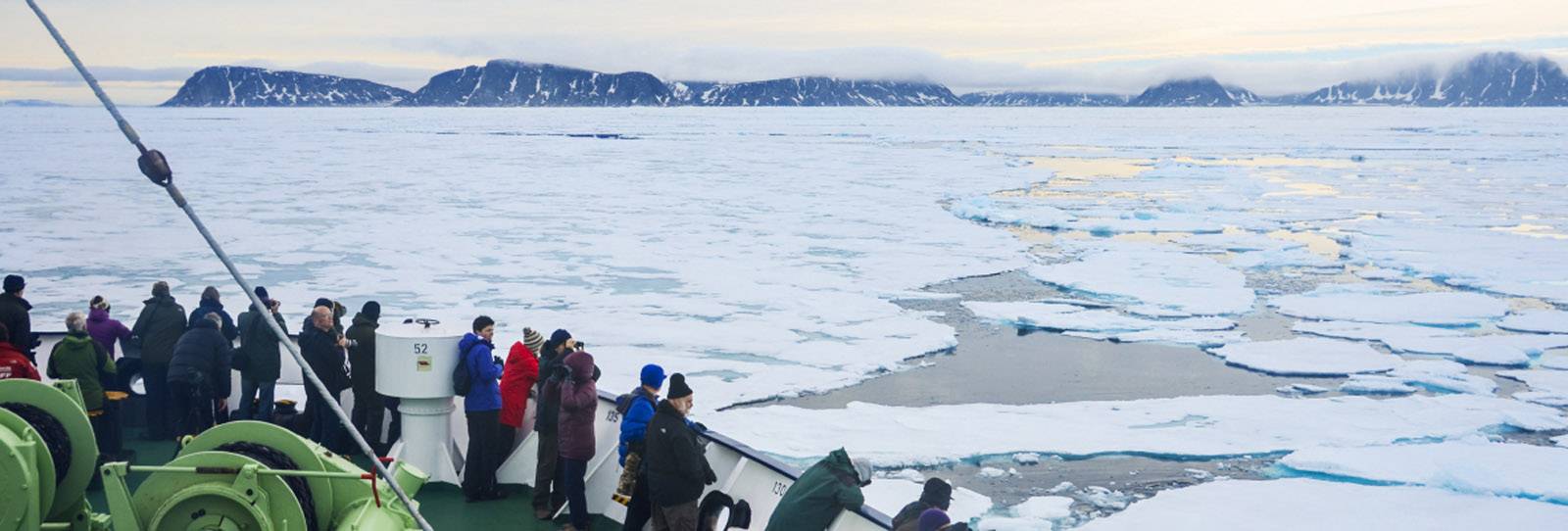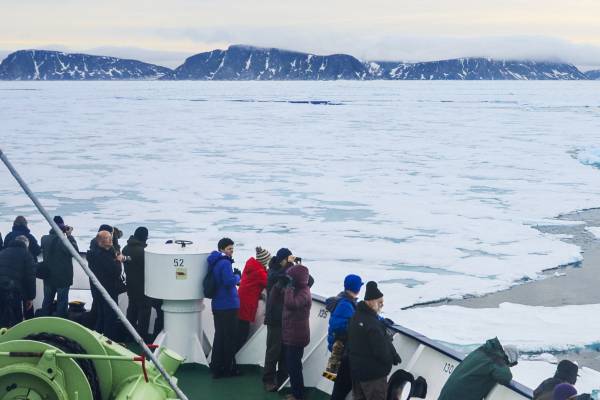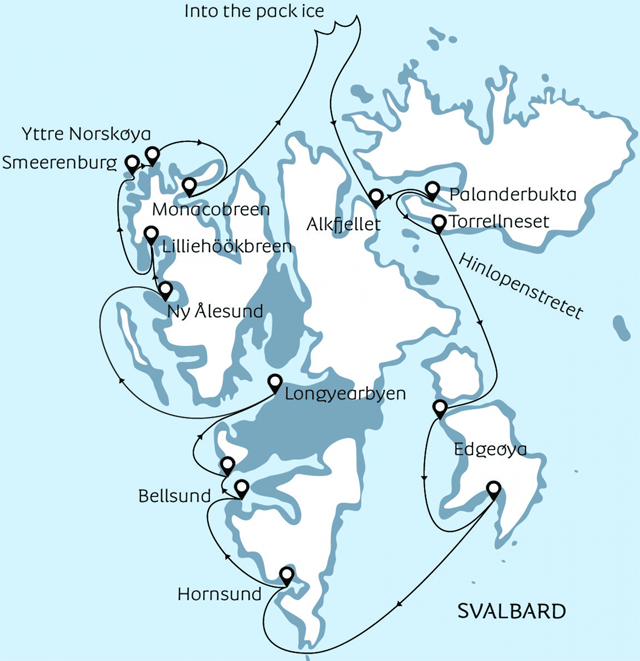HIGHLIGHTS
Enjoy the immense beauty of Svalbard on this Arctic adventure cruise among whales, walruses, polar bears and millions of sea birds. Experience high summer in the Arctic with Ocean Albatros - one of the few ice-class expedition ships built to withstand the North Pole's pack ice.
DATES / RATES
Rates are listed per person
|
| Start Date | End Date | From EUR | From USD |
|---|
Rates are listed per person
|
| Start Date | End Date | From EUR | From USD |
|---|
ITINERARY
DAY
1: LONGYEARBYEN, SPITSBERGEN. EMBARKATION
Arrival
to Longyearbyen, Capital of Svalbard – possibly the
northernmost ‘real’ town in the world.
Our
vessel, the Ocean Albatros, is docked close to the town center. After
boarding and a welcome drink, the Expedition Leader will provide
information about the voyage, the ship's daily routines and the various
security and safety procedures. Before sailing, there will be a
mandatory safety drill. The Captain then takes the ship out of Advent
Fjord and our Arctic adventure commences.
DAY
2: NY ÅLESUND, NY LONDON AND LILIENHÖÖK
GLACIER
During
the ‘night’ (what is night, when the sun never
sets?), we have passed Prins Karls Forland and have arrived in the
magnificent Kongsfjord. Our visit to Svalbard is in the early summer
and this is both the challenge and gift of this special voyage. Winter
ice will possibly block the inner waters of many fjords, but this will
give us the best opportunities to observe the omnipresent –
but still elusive – polar bear, hunting for seals in its
prime habitat. At this time of year the migrating birds have just
arrived. They are all eager to settle and feed to get the best start
for the coming hectic summer months.
Our
first landing will be at Ny Ålesund. This settlement is in
fact further north than Longyearbyen, making it THE northernmost town.
But… is a group of scientific stations, a post office and a
single shop open for a few hours a real town? You will have to judge
for yourself. The setting is nice, the scientific projects are very
interesting, and so is the town history. The Captain will try to get
docked alongside, so we can enjoy an easy walk through the area.
In
the afternoon, we continue further north into the fjord system, and
depending on the ice situation, we may do a Zodiac cruise along the
Lilliehöök Glacier front… or enjoy a
lecture.
DAY
3: FORMER WHALING STATION AT SMEERENBURG AND YTRE NORSKØYA
We
have now entered North West Svalbard, which was declared a national
park in 1973. The day could begin with a slow cruise in Danskergattet,
looking for seals in Virgohamna, before crossing from
Danskøya to Amsterdamøya to make a landing at
Smeerenburg, the legendary whaling town of 17th century. 200-plus men
were living – and quite often dying – here in the
heyday of blubber production.
There
are several interesting places to visit in this northwestern corner of
Spitsbergen. If conditions allow we’ll make a landing on Ytre
Norskøya, where whalers would have their lookout posts.
DAY
4: MONACO GLACIER AND CRUISING TOWARDS THE PACK ICE
During
the night we head to Wood Fjord and its branch, the Liefde
Fjord. Our plan is to embark on a cruise along the broad
glacier front of Monacobreen. This gives a unique insight of the
glacial forces and the unlimited forms of icebergs. The ice front is
named after Albert I of Monaco, who was a major sponsor of Svalbard
research.
During
the afternoon the ship will steer far north towards the edge of the
polar pack ice. How far north only time and weather will tell, but the
main target for us is just the ‘edge’, possibly at
80 degrees north! This is the kingdom of the polar bear! As the pack
ice retreats during summer, polar bears ride the floes north, as this
is where their prey - the seals - resides. Bears who for unfortunate
reasons do not ‘catch’ the ice moving north, are
stranded on Svalbard all summer, and will have to sustain on berries,
eggs and whatever whale cadavers they can find. A hard life indeed!
At
the end of the day, we will start cruising towards the Hinlopen Strait
that divides Spitsbergen and Nordaustlandet.
DAY
5: AMAZING BIRDLIFE AT ALKEFJELLET, POLAR DESERT LANDSCAPE AT
TORRELNESSET
In
the morning we arrive and cruise slowly by the famous Alkefjellet. If
the weather is on “our side” we will have a good
view of the steep cliffs. The whole area is home to a dense
congregation of Brünichs guillemots. There is so many of the
birds, that hardly an inch is free. During the summer the breeding
pairs offer a wild view of frantic activity, both along the cliffs and
in the sea in front.
More
wildlife awaits us as we land at the polar desert landscapes of
Torrelnesset. The beach here is home to a host of walruses that lay
amongst each other. They feed on the clams and any other molluscs that
they can find in the shallows of Svalbard’s waters.
DAY
6: THROUGH THE HINLOPEN STRAIT AND FREEMANSUNDET, LANDING AT
EDGEØYA
The
main issue that can halt a circumnavigation of Spitsbergen is the ice
situation along Hinlopen Strait. If the ice is passable we can make it
through the southern edge of the Strait and cruise through
Freemansundet that separates Barentsøya and
Edgeøya. We enjoy the views of the massive Kapp Lee on our
way and pass through into Storfjorden.
We
plan to make a Zodiac landing along Edgeøya’s
coast. Edgeøya is the third largest island in Svalbard with
an area of more than 5000 square kilometers.
During
the night we will cross the southernmost part of Svalbard, called
Sørkapp. From here we will continue our way up the western
coast.
DAY
7: WILDLIFE AROUND HORNSUND AT ISBJØRNEHAMNA
Now
that we have passed the southern edge of Spitsbergen we arrive at the
entrance to Hornsund. We will be able to see buildings around
Isbjørnhamna on the northern shore. This is a polish
research station, that has been here since 1957. Here research subjects
are: geophysics, seismics, meteorology and the ionosphere. The work
relationship between the polish researchers and the Norwegian polar
institute is very good, which secures the future of the station (as
long as funding continues).
The
fjord is almost 30 kilometers long and many call it the most beautiful,
with many glaciers that calve into the waters as well as towering
mountains along the shores. The mountaintops are most often covered by
dense clouds and East-Spitsbergen current often leads pack ice into the
fjords mouth. In other words, we are guests in a very impressive show
that unfolds before us.
DAY
8: CALL IN BEAUTIFUL BELLSUND, VÅRSOLBUKTA AND CALYPSOBYEN
The
west coast enjoys the warmer water coming up through the Atlantic, so
winter ice should now have melted. This allows us to enter the southern
fjord of Bellsund on this last full day of exploration.
Bellsund
has some of the richest coal layers in Svalbard, and Svea Mine, far
into the fjord, was formerly one of the biggest communities on the
island. But prices went down, and the coal mine is currently being
dismantled.
We
will stay in the fjord entrance and make landings at the
Vårsol Bay. The biggest attraction here is the little auk
cliff. Tundra is richly fertilized by hundreds of thousands of little
auks, which the Svalbard reindeer love to graze. We will go for a nice
walk along the beach – and spot remains from early industrial
eras.
During
lunch, we’ll cross the fjord along the 4 km long (but quite
narrow) island of Akseloya. We will make a Zodiac landing at
Calypsobyen in Recherche Fjord. Coal was extracted here in the early
1900s, but the enterprise never attained full production. Today,
Calypsobyen offers an exciting landing that gives visitors a glimpse of
the era of Neo-Industrialism, when all opportunities for profit were
tried out. A pleasant walk can be made on the tundra behind the
buildings.
DAY
9: PRINCE KARLS FORLAND WITH HERDS OF WALRUSES AROUND POOLEPYNTEN AND
INTO ISFJORDEN
During
the night we have entered Forlandssundet, that separates Prince Karls
Forland from Spitsbergen. Our destination is Poolepynten (Poole Point),
a small headland named after the British whaler Jonas Poole. Today the
area is inhabited by herds of walruses who can be seen (and smelled!)
from a distance. The large mammals flaunt their tusks and whiskers, as
well as their considerable bulk.
After
the visit, we are southbound towards the entrance to the Isfjorden.
On
our way towards Longyearbyen, we hope to get our last glimpses of
wildlife as well as the truly unique landscapes of Svalbard.
DAY
10: LONGYEARBYEN, SPITSBERGEN. DISEMBARKATION
Early
in the morning the ship has returned to our starting point in
Longyearbyen. After breakfast and farewell greetings to the expedition
team and crew, disembarkation will take place. Transfer is arranged to
the airport.
 (Click image to view Ship details)
(Click image to view Ship details)
WHAT'S INCLUDED
- Charter
flight Oslo-Longyearbyen-Oslo
- 10-day/9-night
cruise with Ocean Albatros in a shared outside double stateroom with
private bathroom/toilet in the category chosen
- English-speaking
expedition team
- Nature
hikes and Zodiac cruises per itinerary
- Near-port
town walks with expedition team
- Information
briefings and lectures by expedition team
- Full
board on ship
- Free
coffee, tea and afternoon snacks on the ship
- Welcome
and farewell cocktails
- Taxes,
tariffs and AECO fees
- Special
photo workshop
- Welcome
and farewell cocktails
- Digital
visual journal link after voyage, including voyage log, gallery,
species list and more!
EXCLUSIONS
- Hotel
accommodation in Oslo.
- Travel
insurance.
- Cancellation
insurance.
- Extra
excursions and activities not mentioned in the itinerary.
- Single
room supplement.
- Meals
not on board the ship.
- Beverages
(other than coffee and tea).
- Tips
for the crew (we recommend USD 14 per person per day).
- Personal
expenses.
- Anything
not mentioned under 'Price includes'.
ADVENTURE
OPTIONS
- Zodiac
Cruises
- Photography
- Lectures
- Wildlife
Observations







